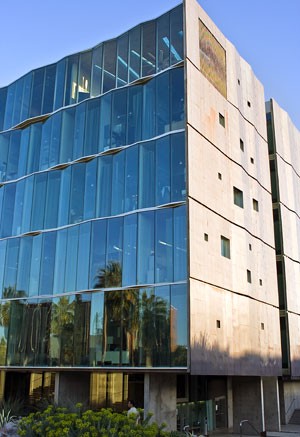From tapping into alternate light and water sources to changing the way people think about energy efficiency, scientists globally continue to take steps toward eco-friendly construction practices.
Building officials are currently taking these advances out of the research lab and onto the UA campus.
Although green living may be all the rage now, the UA was adopting such practices before being kind to the environment was the popular trend, said UA President Robert Shelton.
“”The UA should lead by example,”” he said. “”What’s really important is what we’re doing.””
The standard for building eco-friendly structures has been the Leadership in Energy and Environmental Design system since its global inception in 1998.
LEED employs a ratings system that classifies LEED-certified buildings as silver, gold or platinum based on such factors as structural sustainability, water and energy efficiency, indoor environmental quality, and innovation in design, said Brooks Jeffrey, preservation studies coordinator for the College of Architecture and Landscape Architecture.
The university’s green building practices began more than 100 years ago, when structural experts and architects teamed up to create buildings out of materials that would last for several decades.
To officially establish a green building policy upon taking the UA presidential reins, Shelton said he signed an agreement with the Association for the Study of Higher Education to help the university become a leader in sustainability efforts.
Because of the agreement, it has become a UA policy for all new campus buildings to achieve at least a silver certification from LEED.
Some current green structures on campus include the Meinel Optical Sciences building and the Student Recreation Center expansion, said Peter Dourlein, associate director for UA Facilities Design and Construction.
The Meinel Optical Sciences building’s green stature relies on its building materials and innovative design. The structure’s copper skin is a regional material that saves finances and resources from being used to ship building materials over long distances, he said.
The building’s outside structure is also separated from its inside walls, allowing a natural cooling effect to take place, a measure that saves energy from being used to cool the interior, he said.
Also present in the design are large panes of glass that bring in natural light to save on lighting, he said. Finally, the structure contains permeable surfaces that collect rainwater, rather than just allowing it to run off onto the ground.
“”This creates a heating and cooling system,”” Dourlein said. “”It helps to stop flooding and replenish the water supply.””
The expanded portion of the Rec Center will be composed of materials harmless to the surrounding environment and efficient in terms of structural energy, said Director Juliette Moore.
“”Because of (the center’s) LEED status, students using the Rec Center can also feel proud knowing that they’re helping the environment,”” she said.
Perhaps the model project for sustainability that all other campus buildings should aspire to is the Architecture building, as it adopts green attributes and teaches architecture students how to effectively design a sustainable building, Dourlein said.
Aside from the building taking in natural light because of its glass exterior, its steel composition can be salvaged and recycled to be used in other buildings, he said.
As the structure ages, the steel will become more earth tone-colored, so there is no need to spend money on continually painting the building, he said.
While Arizona State University has a first-of-its-kind School of Sustainability, Shelton said he does not see a similar school in the UA’s future, as he believes such a gesture would turn the UA’s green effort away from a collaboration of different fields of study.
“”We need to spread it out and not just focus our efforts in one place,”” he said. “”We need to get past labeling and get into the actual substance.””
Aside from the environmental benefits, adopting green building practices is also financially beneficial, as many of the green efforts result in energy efficiency, which saves money, Shelton said.
“”You can be green and still be self-serving,”” he said. “”It’s just smart.””
As the UA leads the eco-friendly effort by example, the green trend will spread not only to other universities, but also to surrounding communities as residents become more aware of the importance of sustainability and environmental effects of human activity, Dourlein said.
“”We’re eating our planet,”” he said. “”You can’t have your planet and eat it, too.””









